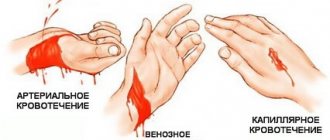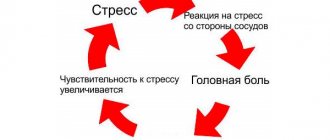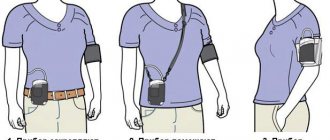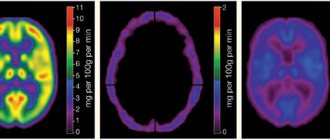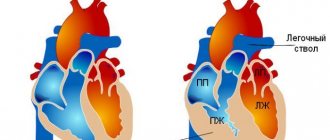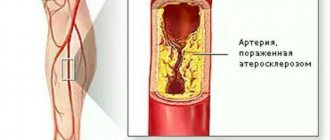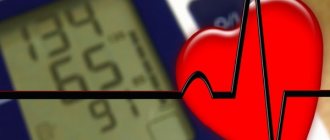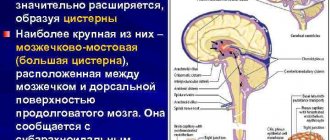Hypertension is a disease characterized by chronic high blood pressure. Hypertensive people are people whose blood pressure readings on a blood pressure monitor consistently exceed 140/90. In this state, blood circulation slows down, causing internal organs to suffer from hypoxia. The prolonged presence of hypertension not only impairs the functioning of all body systems, but can also cause life-threatening complications.
Many people believe that if blood pressure drops significantly in hypertensive patients, this is a clear sign of improvement in their condition. In fact, hypotension is even more dangerous for this group of people than for a healthy person. Indeed, in this case the body is subjected to enormous stress. Therefore, it is important to know how to behave in the event of a sharp decrease in blood pressure in a hypertensive patient.
What to do if your blood pressure drops sharply
Pallor of the skin, facial swelling, chest pain may indicate a decrease in blood pressure due to cardiovascular pathology or pulmonary thromboembolism. You should immediately call a doctor, and allow the victim to take a horizontal position. Measure blood pressure every 25 minutes.
At home, you must maintain peace! A panicked reaction will only make the situation worse.
Severe signs of a stroke, weak nervous reactions of the extremities, and disorientation usually signal a sharp drop in pressure. Possible causes may be: trauma, hemorrhage, brain tumor. It is necessary to lay the person on his side, do not let him lower his head, loosen his clothes and urgently call doctors.
If blood pressure drops in a person suffering from hypertension, you should not bring ammonia to him, use cold water for dousing, or give him alcohol to drink.
If a hypertensive person’s blood pressure drops sharply, then most often this is an overdose of drugs . Sometimes the cause of its changes is cardiac asthma. Its signs: rapid pulse, dizziness, specific “dry” cough, difficulty breathing. If such symptoms are present, the victim should be seated with the body tilted slightly forward. Point your feet down and wait for the doctor.
If a healthy person's systolic and diastolic readings drop sharply, he feels lightheaded and dizzy. You need to try to seat the victim as quickly as possible. His head should be lower than his knees. The patient should not breathe deeply, but evenly.
If possible, it is best to place the victim on his back. Raise his legs and place a cushion and a heating pad under them. An influx of fresh air, sprinkling your face with cold water, hot strong tea or coffee .
massage of the victim’s ears can effectively level out blood pressure . Before the ambulance arrives, you can give the patient a piece of chocolate or candy and cover with a warm blanket.
The external state with a rapid decrease in pressure resembles alcohol intoxication. There is a lack of coordination, inappropriate behavior, decreased vision, tinnitus, and unfocused gaze. It is important not to pass by, provide first aid to the person, and call the medical service.
Unlike a hypertensive crisis, taking pills to increase blood pressure is not recommended. Only a doctor can administer medication after the ambulance arrives.
Methods and means to raise low blood pressure
In many cases, traditional methods of treating hypotension are more effective and safe than pharmaceutical drugs. The following remedies are used in alternative medicine:
- Infusion, decoction or tincture of St. John's wort. To prepare the decoction you will need to pour 1 tablespoon of St. John's wort with 1 cup of boiling water and place on low heat for about 5 minutes. Should be used 2-3 times a day before meals. To prepare the infusion, you need to pour 3 tablespoons of herbs with hot water. Leave the mixture for 2 hours. Also take 2-3 times a day before meals. To obtain St. John's wort tincture, you will need to infuse the dry herb in alcohol for a week. Take 20 drops orally, diluted in 100 ml of water 3-4 times a day before meals.
- Infusion of immortelle flowers. To prepare it, pour 10 g of raw material into 1 glass of boiling water. Take 20 drops a few minutes before meals 2 times a day.
- An infusion of a mixture of hawthorn fruits, strawberry leaves, mistletoe leaves and wormwood herb. Pour all ingredients into 0.5 liters of boiling water and leave for 6 hours. Drink 1 glass 3 times a day 30 minutes before meals.
- Thistle infusion. To prepare, pour 1 cup of boiling water over the leaves of the plant and leave until completely cooled. Take 0.5 cups 3 times a day.
- A collection containing equal quantities of licorice root, string herb, Panaceria fluffy herb, buckwheat herb, and valerian roots. You need to take 5 tablespoons of the mixture, add water and bring to a boil. Then leave for 10-12 hours. Take half an hour before bedtime.
Infusion of immortelle flowers
The main danger posed by low blood pressure is the possible consequences that arise from incorrectly selected treatment. First, you need to establish an accurate diagnosis and the cause of the symptom. For this, it is best to consult a doctor. You cannot self-medicate.
If possible, the person should be placed horizontally and legs raised above head level. Otherwise, you need to at least sit the patient down or lower his head as much as possible. Increased blood flow to the brain will help reduce the risk of fainting. All measures must be taken to increase the flow of fresh air.
Ammonia will also reduce the likelihood of loss of consciousness. You can splash cold water on the skin, rub or pat the ears. A good way to raise blood pressure is massage, which stimulates the baroreceptors. It is done starting from the upper part of the carotid artery, gradually moving to its lower sections, in addition, you need to massage the central part of the back of the head and the base of the skull. It is necessary to force the victim to breathe deeply.
At home
At home, strong sweet tea will help best. Coffee is recommended only for those who drink it rarely. Using brine or any foods with a high (but not excessive) salt content will retain water in the body, which will also increase blood pressure. One of the best recipes is to use honey with cinnamon or lemon.
There are many herbs in nature that are the most harmless and reliable means for eliminating hypotension. To stabilize low blood pressure, infusions, decoctions, and alcohol tinctures of certain types of herbs and complex mixtures are used. Tea made from Rhodiola rosea (golden root) is used to raise blood pressure when overworked.
Infusions based on peppermint, Schisandra chinensis (fruit), Eleutherococcus senticosus (roots), Manchurian aralia (roots), lily of the valley are recommended to be taken by people suffering from chronic low blood pressure instead of tea 3 times a day. Alcohol tinctures of ginseng, Eleutherococcus senticosus, Schisandra chinensis, and Aralia Manchurian are considered the most powerful natural remedies for hypotension. They are taken drop by drop. A decoction or infusion of St. John's wort, licewort and leuzea will help get rid of fatigue.
To increase blood pressure, it is recommended to use essential oils of geranium, ginger, cypress, coriander, lemongrass, nutmeg, neroli, rose (Rose Otto), rosemary, pine, sweet thyme, black pepper, eucalyptus. Essential oils are used during inhalation. Simply inhale them regularly by pouring a few drops onto a napkin.
Contrast showers or warm baths are very useful for low blood pressure, as these procedures stimulate blood circulation. It is necessary to establish a daily routine in order to develop the precise functioning of biological rhythms. You need to spend 8-9 hours a day sleeping. After waking up, you should never get up suddenly.
Causes of pathology
There are physiological mechanisms that regulate human blood pressure. Disturbances in their work always cause it to “jump.”
Such pathological factors include:
- Excessive enlargement of blood vessels due to blood redistribution. For example, with alcohol abuse, as well as as a result of intoxication;
- Large blood loss due to various types of bleeding or dehydration;
- Dysfunction of the endocrine system;
- Allergic reaction to medications;
- Weakening of the heart (due to heart attack, arrhythmia, cardiomyopathy);
- Disturbed nervous regulation of blood vessels (after stress, VSD, stroke, injury).
A sharp decrease in blood pressure can also be caused by non-pathological reasons: pregnancy, old age, fever.
When blood pressure levels are below 80/60, shock may occur:
- infectious-toxic (as a result of intoxication);
- cardiogenic;
- anaphylactic (as a result of allergies);
- hemorrhagic (due to blood loss);
- traumatic.
Extreme low blood pressure is always accompanied by severe disruptions in blood microcirculation.
It happens that symptoms of hypotension cause pulmonary edema. Its signs: pallor, increased heart rate, bubbling coughing, and foamy blood coming out of the mouth. In case of low blood pressure caused by chronic pathology of internal organs or hormonal imbalance, the disease should first be cured.
Consequences
Most often, a decrease in blood pressure in hypertensive patients occurs in the morning. There is orthostatic hypotension and characteristic dizziness when getting out of bed.
Changes in blood pressure lead to negative consequences:
- weaknesses;
- irritability;
- retraction of veins;
- cold sweating;
- numbness of the limbs;
- visual and hearing impairments;
- decreased quality of life;
Low blood pressure causes a decrease in blood volume in the cycle, oxygen hypoxia, the development of ischemic heart disease, stroke, and acute coronary syndrome. It is important to be able to stop the process, or even better, to prevent it.
Prevention
When a person knows his predisposition to changes in blood pressure, he can take measures to prevent these health-threatening situations.
For this:
- You should pay attention to food products. Many of them can either increase or sharply decrease blood pressure.
- Monitor your diet and reduce the amount of fat you consume. Avoid spicy, smoked and fried foods. Drink more fluids.
- Take a contrast shower every day.
- At home, you can maintain moderate physical activity (gymnastics, yoga, cardio, etc.)
- Apply reasonable alternation of periods of work and rest.
- During magnetic storms, reduce physical and emotional stress.
Blood pressure is the most important indicator of human health. For each person, there are optimal values at which life support processes proceed in a comfortable mode.
It is important for hypertensive patients to know the rules of behavior in such a difficult situation for the body. This will help not only maintain health, but also help another person who does not have the necessary information.
At an appointment with a cardiologist, you need to ask what to do if your blood pressure drops and what to do in a given situation. Each case is individual, so the doctor, based on the patient’s health indicators, will give effective advice.
THERE ARE CONTRAINDICATIONS CONSULTATION WITH YOUR DOCTOR IS REQUIRED
Author of the article Svetlana Anatolyevna Ivanova, general practitioner
Question: Why does a person’s blood pressure drop? The reasons can be both physiological (i.e., the body’s reaction to external irritations) and pathological (i.e., a decrease in blood pressure caused by some disease).
An occasional drop in blood pressure may not pose a significant threat, and you can raise your blood pressure at home. Regularly occurring symptoms of hypotension indicate the presence of hidden diseases. In this case, it is good that you need to undergo diagnostics to identify the cause and timely treatment.
Main reasons for pressure drop
Arterial hypotension refers to the so-called multifactorial conditions. Since a decrease in pressure, as a rule, occurs under the influence of a combination of various reasons. Depending on the nature of its origin, hypotension in medicine is divided into two forms: primary and secondary.
In 80% of cases, the development of the primary form of arterial hypotension is caused by neurocirculatory dystonia, as well as a disorder of the vasomotor centers of the brain. Disturbances in these pathologies are functional in nature and are manifested by various disorders of the cardiovascular system, among which low blood pressure can be identified. The main provoking factors are:
- high psycho-emotional stress;
- chronic fatigue, depression;
- inadequate rest (regular lack of sleep);
- psychological trauma experienced in the past;
- physical stress.
A person’s lifestyle plays an important role in this matter. The cause of primary hypotension is often physical inactivity, poor nutrition and intoxication of the body (alcohol, tobacco, chemicals).
Secondary arterial hypotension is directly related to diseases and pathological conditions. For example, diseases such as stomach ulcers, diabetic neuropathy, dumping syndrome, myocarditis, heart failure, hyperthyroidism, anemia, tumor.
A sharp decrease in blood pressure can be observed with a single massive loss of blood (in case of injury) or with regular internal bleeding, which occurs with gynecological diseases or duodenal ulcers.
Other reasons for a drop in blood pressure include:
- lack of vitamins B, C, E;
- acclimatization;
- sudden changes in temperature;
- diet;
- side effect of certain drugs;
- low blood glucose levels;
- dehydration.
There is also such a thing as physiological hypotension. It is characterized by consistently low tonometer readings, which is usually observed with a genetic predisposition or in athletes. Chronic hypotensive patients rarely feel unwell. Their body has long adapted to low blood pressure and circulatory disorders do not occur, but they are not immune from blood pressure falling below normal levels.
Causes of a sharp drop in blood pressure
Blood pressure may drop sharply, a condition called acute hypotension. If the decrease occurs too sharply, the heart may stop, so urgent medical attention is required, especially in case of hypertension.
If possible, you should try to prevent such an abrupt condition. So that the doctor can provide assistance in a timely manner, it is necessary to identify the causes of sudden problems with blood pressure:
- Blood loss in a volume of more than 800 ml. The causes of bleeding may vary: trauma, surgery. Such processes will sharply reduce diastolic pressure below 90 mmHg. Art. The person turns pale, lips become blue, limbs are cold, and the heartbeat quickens.
- Diseases of the cardiovascular system - heart attack, cardiosclerosis, advanced forms of arrhythmia. As blood pressure rapidly decreases, pressure in the blood vessels of the lungs increases sharply. The condition may be accompanied by tachycardia, shortness of breath, and bluish skin.
- Cardiac asthma. The disease also causes a sharp decrease in blood pressure. At this moment, a person may talk about suffocation, complain of an unproductive cough, and increased heart rate. To relieve an attack, a person instinctively sits down, lowering his legs and bending his torso forward.
- Pulmonary edema. This condition, in addition to pale skin and increased heart rate, can be accompanied by a painful cough and the release of foam mixed with blood from the mouth. The veins in the neck stand out strongly, the pulse rises sharply to 120 beats per minute or more.
- Infections with high fever and signs of intoxication.
With prolonged exposure to sunlight, pressure can also drop sharply, because there is a strong release of characteristic components into the bloodstream.
What to do if pressure drops
First of all, it is necessary to exclude the presence of serious diseases. Temporary measures taken to urgently increase blood pressure are not treatment and do not solve the underlying problem. If the pressure drops for the first time, you can try to raise it yourself. Effective and simple ways to raise blood pressure are:
- Taking a drink with hypertensive properties. It could be black coffee or sweet strong tea. Grape juice with 30 drops of ginseng tincture will also help to quickly raise blood pressure.
- Consuming a small amount of salt. For a hypertensive effect, it is necessary to slowly dissolve a pinch of salt without drinking water.
- Acupressure. You can do it yourself or ask a loved one for help. You need to press the central part of the back of the head several times, and then, with some effort, stretch the shoulder girdle. The pressure should be quite strong, but within reasonable limits.
- Increase fluid intake. Hypotension often occurs against the background of dehydration, the presence of which a person may not even be aware of. Sometimes, to raise blood pressure, it is enough to drink 1-2 glasses of water in slow sips.
- Use of hypertensive drugs. If you urgently need to raise blood pressure, and other methods have not been effective, you can resort to medications. It is advisable that the medicine and dosage be selected by a doctor or at least a pharmacist working in a pharmacy. At the same time, it is better not to buy products with a pronounced hypertensive effect, since they have a rather strong effect on the body, which can lead to various complications in the future. For the first time, Citramon, which contains caffeine, may be suitable.
When resorting to the above methods, it is important to remember that they only help raise blood pressure for a while. If, after the cessation of the hypertensive effect, pronounced symptoms of hypotension occur, this is a reason to consult a doctor.
What is the danger of a sharp drop in blood pressure?
A sharp drop in blood pressure never just happens without a reason. There are groups of people who, even with indicators of 105/70, feel normal - this is an individual feature that is usually noted since childhood. But when a sharp drop in blood pressure is accompanied by a deterioration in health, this indicates a threat and requires the help of a doctor.
Some people mistakenly believe that a strong load on blood vessels with high pressure is dangerous, and a sharp decrease cannot lead to serious complications. In fact, it becomes difficult for oxygen to reach the brain, and the risk of ischemic stroke increases. Sudden surges are especially dangerous for people with chronic heart disease, congenital defects, angina pectoris, etc.
The danger of low blood pressure
The occurrence of hypotension is dangerous for pregnant women, because it can threaten the development of serious deviations in the development of the child and even provoke a miscarriage.
Due to a sharp decrease in pressure in any trimester, all tissues in the body lack important nutrition and undergo dystrophy. Thus, problems with the functioning of the heart muscle and central nervous system may gradually arise.
Dangerously low numbers on the blood pressure monitor
Conventionally, the borderline numbers are blood pressure readings of 100/60, but pressure can drop to 90/60, and sometimes much lower. In this case, we are talking about a hypotonic crisis, the consequences of which can be very dangerous for human life. Thus, low blood pressure can lead to fainting and severe head injuries, decreased brain functionality, blurred vision, cardiovascular system disorders, myocardial infarction, and stroke.
All these consequences are caused by oxygen starvation of the tissues of the brain, heart and other organs. It is worth remembering that even if a person managed to survive a hypotensive crisis without medical help, there is a high risk of developing complications in the future, and therefore it is wiser to seek help in advance while the pressure is in the acceptable low range (90/50). First of all, you should focus on the person’s condition - for some, blood pressure of 100/60-100/50 may be critical.
First aid
What to do if there is a sharp drop in blood pressure? When the readings drop below normal suddenly, and the condition worsens within 10-20 minutes, immediate first aid is required. It should be aimed at improving blood flow, thereby toning the vessels. Here are some options on how you can deal with the problem yourself:
- Cold and hot shower. With a sudden change of cold and hot water, the body experiences stress, adrenaline is produced and blood flow improves.
- Massage. If you massage the cervical-collar area, this will have a beneficial effect on the functioning of the circulatory system and will open access to the blood flow to the brain. Of course, in order not to cause harm, you need to first find out exactly which area needs to be massaged and how.
- Products. Some foods, and those that are often on hand, can increase blood pressure in a few minutes. This could be a cup of coffee with dark chocolate, raisins or something salty, since salt itself is contraindicated for hypertensive patients, it can help hypotensive patients.
If a sharp decrease in blood pressure leads to fainting, you should immediately seek medical help. Before specialists arrive, it is important to ensure that the patient is in a horizontal position, has access to fresh air, and is not wearing tight clothing that would interfere with breathing.
Characteristic signs of decreased blood pressure
Not every person has a blood pressure monitor with them or has the opportunity to go to a medical center if they feel unwell. Chronic hypotensive people, as a rule, quickly recognize the symptoms of arterial hypotension, but people with consistently normal blood pressure readings may become confused. You should pay attention to the combination of symptoms that form the overall clinical picture of arterial hypotension:
Characteristic when blood pressure decreases. Lethargy, dizziness, weakness, apathy, etc.
- dull throbbing pain in the temples, ears or back of the head;
- decreased visual and hearing acuity;
- dizziness;
- nausea (sometimes vomiting);
- low performance (absent-mindedness, memory impairment);
- loss of strength, drowsiness;
- stabbing or scratching pain behind the sternum;
- arrhythmia;
- feeling of lack of air;
- coldness of the extremities, pale skin;
- feeling of impending fainting (fainting);
- the appearance of dark spots or flies in the field of vision.
A decrease in blood pressure causes tissue hypoxia, so the vital activity of the body slows down, which also affects the state of the central nervous system. This is why hypotensive people are often susceptible to depression, neurosis and mood swings.
Causes of low blood pressure in pregnant women
From the moment a woman registers for pregnancy, doctors will regularly check her blood pressure levels and keep a detailed chart of the numbers obtained, since not only the health of the expectant mother, but also the child depends on this. Arterial hypotension during pregnancy can be due to physiological and pathological reasons. Physiological ones include:
Increase in the hormone progesterone
Sudden changes in pressure, especially downward, are often a consequence of an increase in the level of the pregnancy hormone progesterone. This phenomenon is usually observed in the first trimester of pregnancy, after which blood pressure levels stabilize.
Formation of the placenta
When an embryo is implanted into the body of the uterus, a new, uteroplacental circulatory system, necessary for feeding the fetus, immediately begins to form. At the same time, the load on the cardiovascular system instantly increases. Now the woman’s body will supply blood to as many as 2 organisms. This is fraught with temporary functional disruptions, which may include hypotension.
Non-compliance with drinking regime
Pregnant women, like everyone else, need to drink water regularly, otherwise dehydration will occur. A decrease in circulating blood volume can lead to a drop in blood pressure and other health problems.
Emotional instability
During pregnancy, a woman’s body undergoes a huge number of changes, including sharp hormonal fluctuations with suppression of the production of some hormones and an increase in the production of others. Worries about the unborn child, your health, or fear of the upcoming birth can have different effects on the level of pressure, provoking its surges.
Deterioration of venous outflow
This is a pathological condition, but it is caused by physiological factors. As the abdomen grows, a woman’s internal organs shift, which can lead to pressure on the arteries and slow blood circulation in the body. At the same time, cardiac output decreases, which causes a decrease in blood pressure.
Often, a decrease in blood pressure also occurs against the background of severe toxicosis or iron deficiency anemia, which requires urgent measures (usually a nutritional correction or the use of iron-containing products is sufficient).
Pathological causes of arterial hypotension during pregnancy include:
Complications during pregnancy
When there is a threat of miscarriage, especially with placental abruption, uterine bleeding is often observed. Loss of blood leads to a decrease in blood pressure, sometimes to critical levels. Hypotension also often develops with polyhydramnios.
Exacerbation of chronic diseases
Pregnancy is the most difficult test for the body, when all systems work to the limit of their capabilities. The result of such a load is often the exacerbation of chronic or even the development of new diseases, the fight against which can lead to a loss of vitality and exhaustion, and this, in turn, to low blood pressure.
Despite the fact that doctors pay more attention to the problem of high blood pressure during pregnancy, hypotension is no less dangerous for the mother and child. Intrauterine hypoxia as a result of slow blood circulation can be the main cause of abnormalities in the development of the fetus or even lead to its death. In this regard, it is necessary to monitor blood pressure indicators and take the necessary measures in time to stabilize the pressure.
Symptoms of a sharp drop in blood pressure
A household tonometer is worth having at home not only for hypertensive patients, but also for everyone else. If, after measuring, its readings are below 70 to 105, then this is the first sign of a problem. Symptoms of low blood pressure are as follows:
- weakness, drowsiness, loss of performance;
- nausea;
- headaches or dizziness;
- pale or bluish skin;
- sweating;
- feeling of anxiety, irritability.
These signs are the most general and do not provide a complete prognosis for hypotension. In any case, if two or more of the symptoms described are present, a pressure gauge should be used. If your readings have dropped, you should definitely consult a doctor as soon as possible. In case of more dangerous complications - sharp pain in the heart, vomiting, cold sweat, bluish nasolabial triangle, short-term loss of consciousness - the patient or loved ones must immediately call an ambulance.
- Kefir baking recipes
- How to quickly increase hemoglobin in the blood
- Automatic watering in a greenhouse
Prevention
Low blood pressure indicates an unhealthy lifestyle, so first of all it is necessary to establish a work and rest schedule, give up bad habits and give preference to healthy foods. For people prone to hypotension, doctors recommend:
- never skip breakfast and stick to small meals;
- drink 2-3 cups of sweet coffee a day, but no later than 4 hours before bedtime;
- be sure to give yourself daily moderate physical activity, because without it, the blood vessels become fragile, and this leads to the development of heart pathologies;
- drink about 2 liters of fluid per day;
- eat more vegetables and fruits;
- harden the body by spending more time in the fresh air; a contrast shower will be very useful;
- undergo a course of therapeutic massage of the cervical-collar area once every six months.
Since pathology is often a consequence of VSD, stress and other conditions associated with central nervous system disorders, it is advisable for the patient to visit a neurologist and psychologist. Prevention of secondary hypotension involves timely treatment of chronic diseases and constant monitoring of blood pressure levels.
Physiological hypotension does not pose a health risk, as does a temporary decrease in blood pressure caused by factors such as fatigue, lack of sleep or hunger. The destructive effect of hypotension on the body begins when blood pressure drops to critical levels. The main task of a person is to prevent the onset of a hypotensive crisis and try to independently raise the pressure or seek medical help in a timely manner.
In this article we will tell you why a person’s blood pressure drops. Let us consider in detail the causes and symptoms of low blood pressure. Let’s also look at why such a condition is so dangerous for human health. In conclusion, we will give you recommendations and advice on how to provide assistance. Low blood pressure, otherwise called hypotension or hypotension. Reduced is considered to be up to the limit of 100/60 mmHg. The “normal” reading is 120/80 mmHg. Art. Why does a person's blood pressure drop?
Treatment
Treatment of hypotension at home is possible if it is primary and is not a symptom of the disease. Sometimes it is enough to become a supporter of a healthy lifestyle, balanced nutrition, learn to relax and be less nervous, and low blood pressure will not bother you with unpleasant symptoms. Doctors say that people with low blood pressure live longer, and they develop atherosclerosis less often and more slowly - the main culprit in the development of cardiovascular diseases.
Principles of an active lifestyle
- Engaging in active sports, dosed physical activity.
- Prolonged stay in the fresh air (skis, skates, bicycles, fishing).
- Avoiding stuffy rooms.
- Hardening: dousing or rubbing with cool water, healing baths with pine extract and sea salt.
- Morning workout.
- Alternation of work and rest regimes.
- Night sleep 8-9 hours.
- A day's rest is recommended.
- You cannot change your body position suddenly, otherwise orthostatic collapse may develop. After sleep, without getting up, do light exercises in bed, move your arms, legs, massage your head and neck. Then lower your legs from the bed, sit for a few minutes, and only then get up.
- If you feel good, there is no need to measure your blood pressure several times a day.
- Find something you like to do, take your mind off sad thoughts.
- Give up bad habits (alcohol, tobacco).
- Do not use diets with severe calorie restriction for weight loss.
- Nutrition - balanced without an abundance of fried, fatty, spicy foods.
- Drinking regimen – at least 2 liters of clean water per day.
- It is advisable to spend your vacation in central Russia during the cool season.
Causes of low blood pressure
Characteristics of the human body
This feature appears at an early age and does not interfere with an active life. People are considered healthy and feel great. At the same time, as soon as the pressure rises to the generally accepted norm, a person’s well-being deteriorates significantly. This feature often appears in the weak and physically undeveloped.
Disturbed lifestyle
A strict diet, fasting, snacking and poor sleep... All this can cause malaise, weakness and dizziness. Low blood pressure is not the worst thing that can happen with a bad lifestyle. For normal functioning, the body needs to receive a balanced diet. It is also important to take care of quality, uninterrupted sleep lasting 7-8 hours.
Sudden blood loss
May be due to injury or nosebleeds. This can quite dramatically reduce blood pressure.
Heart failure
With various heart diseases, the rhythm of the cardiovascular system is disrupted. Blood flow deteriorates and vascular activity weakens, which encourages problems to arise.
Adrenal insufficiency
Impaired kidney function can also cause hypotension. Due to the malfunction, the organ releases the hormone acetylcholine. It causes fever. The person begins to experience stress, weakness and irritability.
Professional sports
People in this category are constantly in tension. Their body works at the limit all the time, experiencing enormous physical stress. In this mode, the body begins to work more economically, and heart beats become less frequent. This leads to a decrease in blood pressure.
Depressed state of health
Present in an episode of apathetic, anhedonic and asthenic depression. In the first case, the individual is indifferent to everything around him. If a person feels a lack of thoughts and sadness, this is characteristic of anhedonic depression. In the third option, excessive fatigue and exhaustion of the body are typical.
Wrap session, visit to baths and saunas
Such thermal procedures lead to an increase in blood vessels. Thanks to this, blood pressure decreases. Soon after the procedure, the condition returns to normal, and the pressure returns to normal. Even a hot bath can cause a similar phenomenon. Typically, during such procedures there is a slight decrease in pressure and this does not lead to complications. On the contrary, sometimes such a shake-up, according to doctors, is beneficial for the body.
Dehydration
It is very important not to trigger this state of the body. More often this is caused by taking diuretic medications, very heavy physical activity and diarrhea. Weakness and dizziness, even a fainting attack, may also appear. There is a possibility of complications - hypovolemic shock. This condition is very dangerous for the functioning of vital organs.
Climate change
With a sharp change in climate, the body needs to adapt to new conditions. This phenomenon can also be found among lovers of mountain peaks. As you rise to a height, the ambient pressure changes and thereby affects the pressure in the vessels.
Taking medications
A number of medications have this side effect. For example, some antibiotics, diuretics (diuretics), antispasmodics, painkillers, adrenergic blockers (drugs that normalize heart function) and antidepressants (when treated in large doses).
Why does a person's blood pressure drop?
Low blood pressure - hypotension - can be inherited or acquired during life due to certain situations.
Impact of external factors
The following external factors can lead to slow blood flow:
- prolonged stay in a state of severe nervous tension;
- sedentary lifestyle;
- constant lack of sleep;
- hazardous working conditions (hot shops, foundries);
- the influence of medications that may be prescribed after surgery on internal organs or during the treatment of cardiac pathologies: diuretics, muscle relaxants, antibiotics, antispasmodics, large doses of sedatives.
Constant lack of sleep can cause low blood pressure
Significant vasodilation, which lowers blood pressure in healthy people, occurs after visiting a bathhouse, sauna, cosmetic procedures (wraps), and thermal baths. Provoking factors for low blood pressure include head injuries, cancer pathologies, and anemia of various origins.
Internal factors
In addition to external sources, which can cause blood pressure to drop, there are also internal reasons - pathological changes in the body. These are diseases that disrupt the speed of blood movement through the vessels: vegetative-vascular dystonia, cardiac pathologies (myocarditis, arrhythmia, various blockades). They slow down the heart, blood pumps through the veins more slowly, which leads to a loss of vascular tone and a decrease in peripheral pressure.
A sharp decrease can be triggered by exacerbation of ulcerative processes in the stomach, inflammation of the pancreas, malfunction of the adrenal glands, as well as heavy bleeding. In addition to pain in places where pathologies are localized, weakness and dizziness may occur. In such cases, blood pressure is restored when the underlying disease is eliminated.
Depression of various kinds (asthenic, anhedonic and apathetic) is another factor that adversely affects peripheral pressure.
Frequent depression negatively affects human health
Hypotension is often a congenital pathology. People with this disease constantly have low blood pressure and feel well. But its upward surges can significantly worsen the quality of life of such patients and require medical intervention.
If your blood pressure drops during pregnancy, the cause of slow blood flow is toxicosis in the early stages, which is quite normal. In the second and third trimester, blood pressure does not fall (with the exception of congenital hypotension), but rises slightly. Therefore, a decrease in tonometer readings in the later stages of gestation should alert you, especially when accompanied by abdominal discomfort and bleeding (threat of miscarriage).
The danger of high blood pressure
If you experience a number of the symptoms described above. If the heart rate increases in a calm state, you should measure the pressure level and contact a medical facility for examination. Since, due to a decrease in blood pressure, blood supply deteriorates, which leads to disruption of the heart and brain. This may also indicate the presence of a pathology that threatens your health. This condition may indicate serious illnesses such as hypocortisolism or myocardial infarction. It is very important to identify the disease in time and begin its treatment immediately.
First aid
If there are obvious symptoms of a sharp decrease in blood pressure, the first thing you need to do is call an ambulance. Next, take certain measures to normalize the condition.
- To improve blood supply, lie down and raise your legs above head level;
- If the first step cannot be completed, then do the following. Take a sitting position and lower your head between your legs as low as possible;
- Eat a product containing a lot of salt, such as pickled cucumber;
- Drink enough water or tea;
- Inhaling a mixture of aromatic oils (mint, camphor and rosemary) will also help stabilize blood pressure.
Tips for feeling better
First you need to identify the causes of low blood pressure, whether it is associated with any disease. When a disease is identified, it begins to be treated. If the condition is not critical, the doctor may prescribe to eliminate the symptoms and improve the general condition with the following recommendations:
- Adequate water intake (at least 2 liters per day);
- Full, uninterrupted sleep (7-8 hours minimum);
- Do not get up abruptly after sleep or rest;
- Morning exercises and an active lifestyle (to maintain tone);
- Regular walks;
- Change the hot shower to a contrast shower;
- Visiting the pool or hardening;
- A complete balanced diet, eat often in small portions;
- Eat more salty and protein foods.
The values of a person’s blood pressure at which he feels comfortable are individual for each person. During the day, these indicators may change several times. But if these are not dramatic changes, then people do not notice anything special. Why does a person’s blood pressure drop sharply? A sharp drop in pressure (hypotension) indicates that a malfunction of organs or systems has occurred in the body, caused by internal or external factors.
Characteristic symptoms
Hypertensive patients get used to the fact that their blood pressure is almost always higher than normal, so they often do not pay due attention to the manifestations of a sharp drop in pressure. This happens because patients cannot distinguish the symptoms of the disorder.
The pathology can be recognized in time and assistance can be provided if symptoms develop, indicating that the pressure begins to drop sharply:
- severe paleness of the skin;
- blue lip tint;
- profuse cold sweat, first on the face, and then gradually throughout the body;
- coldness of the extremities;
- chills;
- sinking of veins;
- numbness of fingers, numbness of skin;
- tinnitus, feeling of being stunned;
- sudden darkening of the eyes.
Weakness when pressure drops
With a sharp drop in pressure, inappropriate behavior can sometimes develop:
- rave;
- unsteady gait;
- loss in time;
- a person ceases to recognize relatives and friends.
If timely assistance is not provided, fainting occurs.
The condition with a sharp drop in blood pressure is similar to severe intoxication after alcohol, so people can often pass by without taking measures to help. Sometimes patients themselves do not pay enough attention to obvious symptoms and go to bed, thinking that it is overwork. If your blood pressure is high, it is forbidden to reduce it sharply, otherwise an attack of hypertension may be followed by a hypotensive crisis.
Causes of pressure surges
When blood pressure drops, the reasons are that due to a decrease in the tone of the blood vessels, the blood flow moving towards the brain is not properly filled. As a result, there is a disruption in the supply of oxygen to the brain, so-called hypoxia, which leads to the appearance of symptoms characteristic of hypotension.
But this is not the only reason why a person’s blood pressure drops. In addition to vascular tone, pressure changes cause disruption of the cardiovascular system, in particular, weakening of the heart muscle, which, during intense physical activity, cannot pump a sufficient amount of blood to the internal organs and brain of a person.
Condition of the vascular system
The reasons for the sharp drop in pressure lie in the volume of blood circulating in the body and its consistency. If blood volume drops sharply, this indicates bleeding. It can be not only external, but also internal. The latter is much more dangerous because it is not detected visually, but poses a more serious threat to life due to difficult diagnosis.
This condition can occur under the following conditions:
- rupture of internal organs (trauma, accident);
- perforation of a stomach ulcer;
- rupture of large vessels;
- ectopic pregnancy;
- traumatic brain injury.
If the pressure suddenly drops significantly, this can lead to collapse. This is a very dangerous condition in which blood circulation to the brain is disrupted, which causes hypoxia. If you do not urgently remove the patient from this condition, the development of irreversible processes and even death is likely.
Collapse can be caused by complications of the following diseases:
- diabetes;
- anaphylactic shock;
- renal failure;
- myocardial infarction;
- stroke;
- pain shock.
Adaptation of the body
A sharp drop in pressure is typical for young people. At a young age, the tone of blood vessels is slightly reduced, which is a physiological cause of low blood pressure. Therefore, to maintain performance, young people often take caffeine-containing foods and drinks.
Young people often subject their bodies to physical stress. This applies not only to work, but also to training in the gym.
Blood pressure may drop while using a sauna. When exposed to high temperatures, the lumen of blood vessels increases and blood circulation is disrupted. As a result, there is insufficient oxygen supply to the tissues, which leads to signs of hypotension.
A sudden jump in pressure is caused by increased physical activity, as well as a state of stress or severe fear. In this case, there is a sharp spasm of the blood vessels and disruption of blood flow to the internal organs.
A decrease in blood pressure is caused by a disruption in the conduction of nerve impulses from the brain to the heart muscle. As a result, bradycardia occurs (decreased heart rate), which leads to a decrease in blood pressure. Sharp changes in blood pressure are observed in women during menopause.
This is due to age-related hormonal changes, mood swings and emotional instability. During this period, women experience an imbalance between the sex hormones estrogen and progesterone, which leads to an increase or decrease in blood pressure.
Dehydration
A drop in blood pressure can cause disturbances in blood concentration and thickening. This occurs with prolonged lack of water and food. Due to a disruption in the flow of fluid into the body, the liquid part of the blood (plasma) is partially released through sweat, leading to a decrease in the amount of circulating blood. A similar condition is caused by following a diet that reduces fluid intake.
Other reasons
Blood pressure that decreases is typical for people with sleep rhythm disturbances. When a person lacks sleep, his well-being and performance are impaired. He constantly feels tired and apathetic to everything around him. Blood pressure may drop due to infectious diseases associated with prolonged fever, diarrhea, and vomiting. In such conditions, the patient loses a lot of fluid, which leads to an increase in blood density and a decrease in its volume.
The blood pressure of a hypertensive patient will drop sharply, possibly due to a single use of a large dose of hypertensive drugs. If a patient has arterial hypertension, you cannot immediately take a large dose of tablets that lower blood pressure; you need to take them from the minimum dose, gradually increasing it.
When using certain medications, blood pressure readings change. This is warned about in the instructions for use of the drug. For many people, pressure surges are associated with changes in weather or climatic conditions.
Physiological hypotension
Low blood pressure or hypotension is diagnosed when there is a persistent decrease in readings when the pressure drops below 90/60 mmHg. Hypotension is not always a sign of pathology. Hypotension is often identified as an incidental finding when measuring blood pressure. This type of hypotension is physiological.
Variants of physiological hypotension occur:
- In people with a predominance of the parasympathetic nervous system. It is especially often observed in fragile, asthenic women. No clinical picture appears; on the contrary, when the pressure rises to normal levels, their health worsens.
- In athletes, decreased blood pressure and bradycardia are a compensatory mechanism in response to the intensity of physical activity during training.
- People living in high mountain areas have low blood pressure as a result of adaptation to rarefied mountain air.
- In pregnant women.
- In teenage children.
Features of hypotension in pregnant women
If a woman had low blood pressure before pregnancy, which did not bother her, then maternal hypotension is an unfavorable fact for the fetus. Due to poor blood supply, fetal hypoxia may occur and, as a result, the birth of a premature, low-weight baby.
If blood pressure drops during a complicated pregnancy, the cause is uterine bleeding with a threat of miscarriage.
In children, arterial hypotension is a common phenomenon that develops even at the stage of intrauterine development during pathological pregnancy. The first symptoms appear at puberty and are associated with hormonal fluctuations. These are functional disorders that manifest themselves in the form of cardialgia (pain in the heart at rest and after physical activity).
In addition to cardiac syndrome, adolescents experience sudden mood swings, a feeling of lack of air, suspiciousness, gloomy mood, and poor adaptation in a team. Such children have no friends, lead a secluded lifestyle, and spend most of their time on the computer.
Primary pathological hypotension
Pathological primary hypotension does not accompany any disease. This condition is not life-threatening, but significantly impairs the patient's quality of life.
Causes:
- Strong psycho-emotional stress.
- Passive lifestyle.
- Strict diets, fasting.
- Genetic predisposition.
- Mental or physical stress.
- Meteorological dependence (atmospheric pressure fluctuations, heat, cold).
- Work in difficult climatic and geophysical conditions (miners, miners), the influence of radiation.
- Long-term use of medications: antidepressants, diuretics.
Symptoms of stable low blood pressure not related to illness:
- Constant unpleasant sensations in the head area associated with impaired vascular circulation: headache, dizziness. The pain is heterogeneous: from pulsating to dull aching, localized in different parts of the head (back of the head, forehead, temple).
- When the atmospheric pressure changes or the weather changes, patients feel a deterioration in their health.
- Dizziness with sudden changes in body position. Fainting is possible.
- Weakness, fatigue, decreased performance at the end of the working day.
- Apathy, loss of interest in life up to depression. Emotional lability, irritability, tearfulness.
- Discomfort behind the sternum, sometimes pain and palpitations, not associated with nervous or physical stress.
- Patients do not tolerate heat and cold well, their extremities are cold, and they often freeze.
In such patients, blood pressure decreases after visiting a bathhouse, sauna, sunbathing, after intense training and physical work. If this is accompanied by dizziness, nausea, or chest pain, you should seek medical help.
Women during menopause are at risk for pressure changes. At this age, dishormonal disorders occur associated with the attenuation of ovarian function.
Secondary pathological hypotension
Secondary pathological hypotension as a symptom develops in humans with somatic diseases of the central nervous system, cardiovascular system, adrenal glands, thyroid gland, osteochondrosis, tumors, alcoholism, diabetes.
A persistent drop in blood pressure causes hypoxia in the tissues. This affects the functional state of the brain, heart muscle, endocrine organs, and kidneys.
Vascular changes lead to disruption of the supply of nutrients and oxygen to the brain. Memory deterioration gradually increases, higher brain functions and creative skills decrease.
A weakened heart muscle with hypotension is not able to cope with pushing blood to the human organs and brain.



